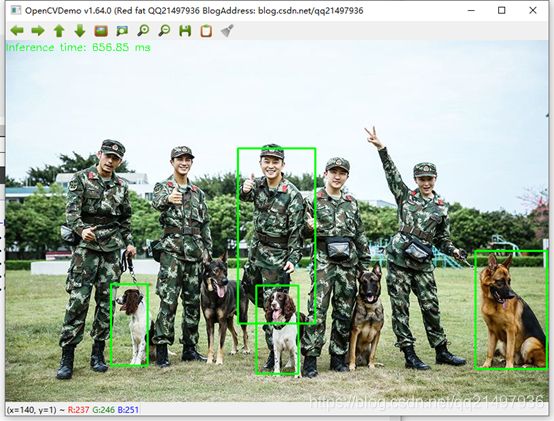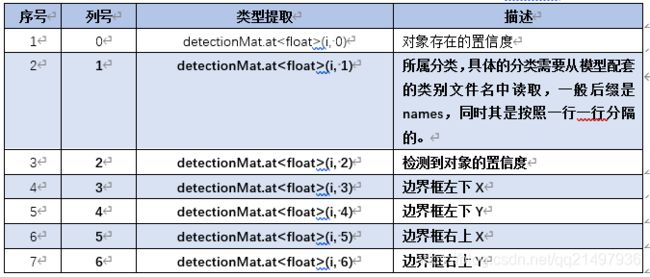若该文为原创文章,转载请注明原文出处
本文章博客地址:https://blog.csdn.net/qq21497936/article/details/109194717
各位读者,知识无穷而人力有穷,要么改需求,要么找专业人士,要么自己研究
红胖子(红模仿)的博文大全:开发技术集合(包含Qt实用技术、树莓派、三维、OpenCV、OpenGL、ffmpeg、OSG、单片机、软硬结合等等)持续更新中…(点击传送门)
OpenCV开发专栏(点击传送门)
上一篇:《OpenCV开发笔记(七十一):红胖子8分钟带你深入级联分类器训练》
下一篇:持续补充中…
前言
级联分类器的效果并不是很好,准确度相对深度学习较低,本章使用opencv通过tensorflow深度学习,检测已有模型的分类。
Demo
可以猜测,1其实是人,18序号类是狗,因为笔者未找到对应的分类具体信息。
Tensorflow模型下载
https://github.com/opencv/opencv_extra
(注意:未找到对应的分类具体信息。)
OpenCV深度识别基本流程
opencv3.4.x支持了各种模型。
支持的模型
opencv3.4.x支持一下深度学习的模型:
- caffe:.caffemodel
官网:http://caffe.berkeleyvision.org
- tensorflow:.pb
官网:https://www.tensorflow.org
- torch:.t7 | .net
官网:http://torch.ch
- darknet:.weights
官网:https://pjreddie.com/darknet
- DLDT:.bin
官网:https://software.intel.com/openvino-toolkit
操作步骤:tensorflow
步骤一:加载模型和配置文件,建立神经网络。
根据不同的模型,使用cv::dnn::readNetFromXXX系列函数进行读取,opencv3.4.x系列支持的dnn模型(支持模型往上看)。
举例tensorflow模型如下:
std::string weights = "E:/qtProject/openCVDemo/dnnData/" \
"ssd_mobilenet_v1_coco_2017_11_17/frozen_inference_graph.pb";
std::string prototxt = "E:/qtProject/openCVDemo/dnnData/" \
"ssd_mobilenet_v1_coco_2017_11_17.pbtxt";
cv::dnn::Net net = cv::dnn::readNetFromTensorflow(weights, prototxt);
步骤二:将要预测的图片加入到神经网络中
加入之后,需要识别图片,那么需要把图片输入到神经网络当中去,如下:
cv::Mat mat;
cv::Mat blob;
mat = cv::imread("E:/testFile/14.jpg");
cv::dnn::blobFromImage(mat, blob);
步骤三:分类预测,获取识别的结果
输入之后,就进行识别,识别是向前预测(分类预测),并且拿到结果。
cv::Mat prob = net.forward();
对于预测的结果,存于cv::Mat类型的prob,然后需要统一对prob进行处理,使其成为我们可以使用的数据,代码如下:
cv::Mat detectionMat(prob.size[2], prob.size[3], CV_32F, prob.ptr
对于从结果prob转换为detectionMat后,其结构如下:
cv::Mat为多行七列,每一行代表一个检测到的分类,具体列信息如下表:
(注意:具体的使用,请参照“步骤四”)
步骤四:对达到置信度的可以通过输出的mat进行分类和框选
cv::Mat detectionMat(prob.size[2], prob.size[3], CV_32F, prob.ptr
// 置信度预制,大于执行度的将其使用rect框出来
float confidenceThreshold = 0.75;
for(int i = 0; i < detectionMat.rows; i++)
{
float confidence = detectionMat.at
if (confidence > confidenceThreshold)
{
// 高于置信度的,获取其x、y、以及对应的宽度高度,进行框选
int classId = (detectionMat.at
int xLeftBottom = static_cast
int yLeftBottom = static_cast
int xRightTop = static_cast
int yRightTop = static_cast
cv::Rect object((int)xLeftBottom,
(int)yLeftBottom,
(int)(xRightTop - xLeftBottom),
(int)(yRightTop - yLeftBottom));
cv::rectangle(mat, object, cv::Scalar(0, 255, 0), 2);
qDebug() << __FILE__ << __LINE__
<< classId
<< confidence << confidenceThreshold
<< object.x << object.y << object.width << object.height;
}
}
函数原型
读取tensorflow模型与配置文件函数原型
Net readNetFromTensorflow(const String &model,
const String &config = String());
从文件中读取。
参数一:用二进制协议描述网络体系结构的.pb文件的路径;
参数二:包含protobuf格式的文本图形定义的.pbtxt文件的路径。生成的网络对象由文本图构建,使用来自二进制的权重让我们更灵活些;
Net readNetFromTensorflow(const std::vector
const std::vector
从缓存中读取。
参数一:包含pb文件内容的bufferModel缓冲区;
参数二:包含pbtxt文件内容的bufferConfig缓冲区;
Net readNetFromTensorflow(const char *bufferModel,
size_t lenModel,
const char *bufferConfig = NULL,
size_t lenConfig = 0);
参数一:包含pb文件内容的bufferModel缓冲区;
参数二:bufferModel缓冲长度;
参数三:包含pbtxt文件内容的bufferConfig缓冲区;
参数四:bufferConfig缓冲长度;
读取图片(需要识别的)函数原型
Mat blobFromImage(InputArray image,
double scalefactor=1.0,
const Size& size = Size(),
const Scalar& mean = Scalar(),
bool swapRB=false,
bool crop=false,
int ddepth=CV_32F);
void blobFromImage(InputArray image,
OutputArray blob,
double scalefactor=1.0,
const Size& size = Size(),
const Scalar& mean = Scalar(),
bool swapRB=false,
bool crop=false,
int ddepth=CV_32F);.
Mat blobFromImages(InputArrayOfArrays images,
double scalefactor=1.0,
Size size = Size(),
const Scalar& mean = Scalar(),
bool swapRB=false,
bool crop=false,
int ddepth=CV_32F);
void blobFromImages(InputArrayOfArrays images,
OutputArray blob,
double scalefactor=1.0,
Size size = Size(),
const Scalar& mean = Scalar(),
bool swapRB=false,
bool crop=false,
int ddepth=CV_32F);
从图像创建区域。可选择从中心调整和裁剪图像。
参数一:图像输入图像(1、3或4通道);
参数二:大小输出图像的空间大小;
参数三:从通道中减去平均值的平均标量。价值是有意的,如果image有BGR顺序,swapRB为真,则按(mean-R,mean-G,mean-B)顺序排列;
参数四:图像值的缩放因子乘数;
参数五:swapRB标志,指示交换第一个和最后一个通道,在三通道图像是必要的;
参数六:裁剪标志,指示调整大小后是否裁剪图像;
参数七:输出blob的深度,选择CV_32F或CV_8U;
设置神经网络输入函数原型
void cv::dnn::Net::setInput(InputArray blob,
const String& name = "",
double scalefactor = 1.0,
const Scalar& mean = Scalar());
设置网络的新输入值。
参数一:一个新的blob。应具有CV_32F或CV_8U深度。
参数二:输入层的名称。
参数三:可选的标准化刻度。
参数四:可选的平均减去值。
深度检测识别(向前预测)函数原型
void cv::dnn::Net::Mat forward(const String& outputName = String());
向前预测,返回指定层的第一个输出的blob,一般是返回最后一层,可使用cv::Net::getLayarNames()获取所有的层名称。
参数一:outputName需要获取输出的层的名称
Demo源码
void OpenCVManager::testTensorflow()
{
// 训练好的模型以及其模型的后缀名
// .caffemodel (Caffe, http://caffe.berkeleyvision.org/)
// .pb (TensorFlow, https://www.tensorflow.org/)
// .t7 | *.net (Torch, http://torch.ch/)
// .weights (Darknet, https://pjreddie.com/darknet/)
// .bin (DLDT, https://software.intel.com/openvino-toolkit)
// https://github.com/opencv/opencv/wiki/TensorFlow-Object-Detection-API
std::string weights = "E:/qtProject/openCVDemo/dnnData/" \
"ssd_mobilenet_v1_coco_2017_11_17/"frozen_inference_graph.pb";
std::string prototxt = "E:/qtProject/openCVDemo/dnnData/" \
"ssd_mobilenet_v1_coco_2017_11_17.pbtxt";
cv::dnn::Net net = cv::dnn::readNetFromTensorflow(weights, prototxt);
if(net.empty())
{
qDebug() << __FILE__ << __LINE__ << "net is empty!!!";
return;
}
cv::Mat mat;
cv::Mat blob;
// 获得所有层的名称和索引
std::vector
int lastLayerId = net.getLayerId(layerNames[layerNames.size() - 1]);
cv::Ptr
qDebug() << __FILE__ << __LINE__
<< QString(lastLayer->type.c_str())
<< QString(lastLayer->getDefaultName().c_str())
<< QString(layerNames[layerNames.size()-1].c_str());
#if 0
// 视频里面的识别
cv::VideoCapture capture;
if(!capture.open("E:/testFile/4.avi"))
{
qDebug() << __FILE__ << __LINE__ << "Failed to open videofile!!!";
return;
}
#endif
while(true)
{
#if 1
// 读取图片识别
mat = cv::imread("E:/testFile/15.jpg");
if(!mat.data)
{
qDebug() << __FILE__ << __LINE__ << "Failed to read image!!!";
return;
}
#else
// 视频里面的识别
capture >> mat;
if(mat.empty())
{
cv::waitKey(0);
break;
}
#endif
cv::dnn::blobFromImage(mat, blob);
net.setInput(blob);
// 推理预测:可以输入预测的图层名称
// cv::Mat prob = net.forward("detection_out");
cv::Mat prob = net.forward();
// 显示识别花费的时间
std::vector
double freq = cv::getTickFrequency() / 1000;
double t = net.getPerfProfile(layersTimes) / freq;
std::string label = cv::format("Inference time: %.2f ms", t);
cv::putText(mat, label, cv::Point(0, 15), cv::FONT_HERSHEY_SIMPLEX, 0.5, cv::Scalar(0, 255, 0));
cv::Mat detectionMat(prob.size[2], prob.size[3], CV_32F, prob.ptr
// 置信度预制,大于执行度的将其使用rect框出来
float confidenceThreshold = 0.75;
for(int i = 0; i < detectionMat.rows; i++)
{
float confidence = detectionMat.at
if (confidence > confidenceThreshold)
{
// 高于置信度的,获取其x、y、以及对应的宽度高度,进行框选
int classId = (detectionMat.at
int xLeftBottom = static_cast
int yLeftBottom = static_cast
int xRightTop = static_cast
int yRightTop = static_cast
cv::Rect object((int)xLeftBottom,
(int)yLeftBottom,
(int)(xRightTop - xLeftBottom),
(int)(yRightTop - yLeftBottom));
cv::rectangle(mat, object, cv::Scalar(0, 255, 0), 2);
qDebug() << __FILE__ << __LINE__
<< classId
<< confidence << confidenceThreshold
<< object.x << object.y << object.width << object.height;
}
}
cv::imshow(_windowTitle.toStdString(), mat);
cv::waitKey(0);
}
}
对应工程模板v1.64.0
openCVDemo_v1.64.0_基础模板_tensorFlow分类检测.rar。
入坑
入坑一:加载模型时候错误
错误
原因
.pb模型文件与.pbtxt文件不对应,版本也有关系。
解决
更换模型,使用正确的pb与pbtxt对应的文件。
上一篇:《OpenCV开发笔记(七十一):红胖子8分钟带你深入级联分类器训练》
下一篇:持续补充中…



